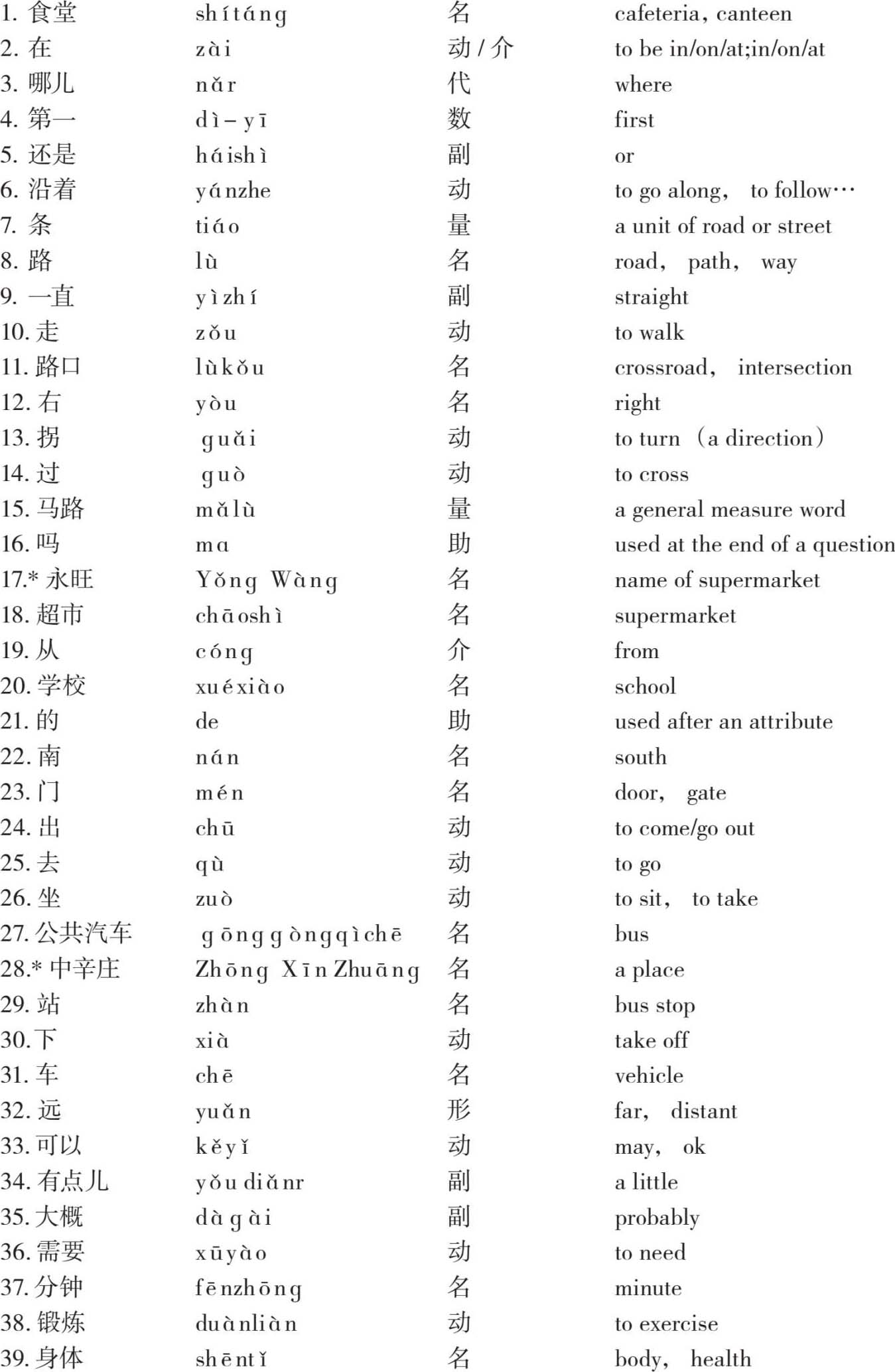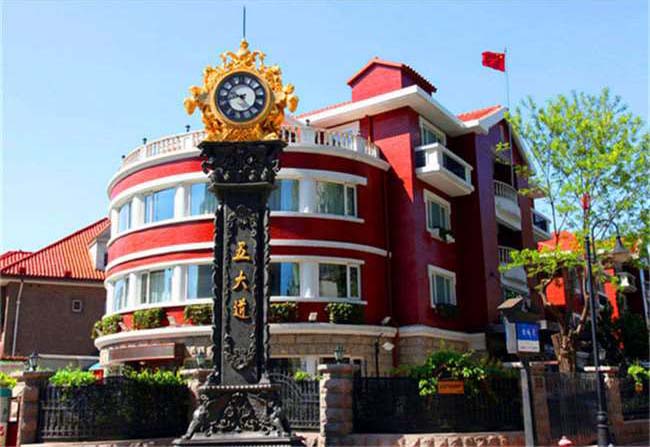





1.这件衣服多少钱?How much is this piece of clothes?
2.太贵了,便宜一点儿吧。It is too expensive.Cheaper,please.
3.我要三个苹果、四个香蕉。I'd like three apples,four bananas.
4.一共多少钱?How much is that altogether?
售货员:您好!您买什么?
Shòu huò yuán:Nín hǎo!Nín mǎi shén me?
李萍:请问,这件衣服多少钱?
Lǐ Pínɡ:Qǐnɡ wèn,zhè jiàn yī fu duō shǎo qián?
售货员:268块。
Shòu huò yuán:Liǎnɡ bǎi liù shí bā kuài。
李萍:太贵了,便宜一点儿吧。
Lǐ Pínɡ:Tài ɡuì le,pián yi yì diǎnr bɑ。
售货员:258块。
Shòu huò yuán:Liǎnɡ bǎi wǔ shí bā kuài。
李萍:200块,行不行?
Lǐ Pínɡ:Liǎnɡ bǎi kuài,xínɡ bu xínɡ?
售货员:好吧,给您。
Shòu huò yuán:Hǎo bɑ,ɡěi nín。
李萍:谢谢!
Lǐ Pínɡ:Xiè xie!
售货员:不客气!
Shòu huò yuán:Bú kè qi!
张雨:请问,苹果多少钱?
Zhānɡ Yǔ:Qǐnɡ wèn,pínɡ ɡuǒ duō shǎo qián?
售货员:三块一斤。
Shòu huò yuán:Sān kuài yì jīn。
张雨:香蕉呢?
Zhānɡ Yǔ:Xiānɡ jiāo ne?
售货员:五块。
Shòu huò yuán:Wǔ kuài。
张雨:我要三个苹果、四个香蕉。一共多少钱?
Zhānɡ Yǔ:Wǒ yào sān ɡè pínɡ ɡuǒ、sì ɡe xiānɡ jiāo。Yí ɡònɡ duō shǎo qián?
售货员:十五块。
Shòu huò yuán:Shí wǔ kuài。


汉语拼音的声调必须标在元音字母上。当一个韵母含有两个或两个以上元音字母时,调号标准在主要元音上,根据ɑ、o、e、i、u、ü的顺序选择。注意,iu是例外,声调标在u上。轻声不标声调。
Tone marks of pinyin must be put above vowels.When there are two or more vowels in the final of a syllable, the tone should be marked on the main vowels according to the sequence of“ɑ, o, e, i, u, ü”。Note that“iu”is the exception, and the tone should be marked on“u”.Neutral tone is not marked.
ɑ、o、e开头的音节连接在其他音节后面时,要用隔音符号“’”隔开,避免混淆。如nǚ’ér(女儿)。
When a syllable beginning with ɑ, o or e is attached to another syllable, the dividing mark“'”is supposed to be used to avoid confusion.



一个人从1开始,每个人轮流数数,说到含有7或者7的倍数时,拍手,不说出数字,下一个同学继续数数。犯规的人表演节目,说的太慢也要表演节目。
One by one, students shout out Chinese numbers in sequential order starting with 1.Every time a student encounters a number that has the digit 7 or is the multiple of 7, the student should clap his/her hands without speaking.If a student forgets to do this, or act slowly, he/she must give a performance for the class.
朗读下列音节,注意声调标注的位置Read the syllabus and pay attention to the positions of the tone marks.


中国的法定货币为人民币(¥),单位为元,人民币辅币单位为角、分。
1元=10角,1角=10分。目前主要流通的纸币有:1角、5角,1元、5元、10元、20元、50元、100元;硬币有:1角、5角和1元。
The official currency of China is Renminbi (¥).The main unit is RMB and auxiliary units are jiao and fen.1 yuàn = 10 jiao, 1 jiao = 10 fen.Presently, the major paper currency in circulation are: 1 jiao, 5 jiao, 1 yuàn, 5 yuàn, 10 yuàn, 20 yuàn, 50 yuàn, 100 yuàn; coins include:1 jiao, 5 jiao and 1 yuàn.

1.食堂在哪儿?Where is the cafeteria?
2.第一食堂还是第二食堂?Cafeteria No.1 or No.2?
3.你沿着这条路一直走,在第一个路口右拐,就能看到第一食堂了。Go along the road,take the first turning on the right,you will see Cafeteria No.1.
4.从学校的南门出去,坐629路或者704路公交车,在中辛庄站下车。Go out from the southern main entrance,take the bus No.629 or No.704,and get off at Zhong Xin Zhuang.
张雨:李萍,食堂在哪儿?
Zhānɡ Yǔ:Lǐ Pínɡ,shí tánɡ zài nǎr?
李萍:第一食堂还是第二食堂?
Lǐ Pínɡ:Dì-yī shí tánɡ hái shì dì-èr shí tánɡ?
张雨:第一食堂吧。
Zhānɡ Yǔ:Dì-yī shí tánɡ bɑ。
李萍:你沿着这条路一直走,在第一个路口右拐,就能看到第一食堂了。
Lǐ Pínɡ:Nǐ yán zhe zhè tiáo lù yì zhí zǒu,zài dì yī ɡe lù kǒu yòu ɡuǎi,jiù nénɡ kàn dào dì-yī shí tánɡ le。
张雨:沿着这条路一直走,在第一个路口右拐。过马路吗?
Zhānɡ Yǔ:Yán zhe zhè tiáo lù yì zhí zǒu,zài dì yī ɡe lù kǒu yòu ɡuǎi。Guò mǎ lù mɑ?
李萍:不过马路。
Lǐ Pínɡ:Bú ɡuò mǎ lù。
张雨:好,谢谢!
Zhānɡ Yǔ:Hǎo,xiè xie!
李萍:不客气。
Lǐ Pínɡ:Bú kè qi。
大卫:老师,请问,永旺超市在哪儿?
Dà Wèi:Lǎo shī,qǐnɡ wèn,Yǒnɡ Wànɡ chāo shì zài nǎr?
张老师:从学校的南门出去,坐629路或者704路公共汽车,在中辛庄站下车。
Zhānɡ lǎo shī:Cónɡ xué xiào de nán mén chū qù,zuò liù èr jiǔ lù huò zhě qī línɡ sì lù ɡōnɡ ɡònɡ qì chē,zài Zhōnɡ Xīn Zhuānɡ zhàn xià chē。
大卫:远吗?老师。
Dà Wèi:Yuǎn mɑ?Lǎo shī。
张老师:不远,4站就到了。
Zhānɡ lǎo shī:Bù yuǎn,sì zhàn jiù dào le。
大卫:老师,我走路去,可以吗?
Dà Wèi:Lǎo shī,wǒ zǒu lù qù,kě yǐ mɑ?
张老师:走路有点儿远,你从南门出去,右拐,一直走,大概需要40分钟。
Zhānɡ lǎo shī:Zǒu lù yǒu diǎnr yuǎn,nǐ cónɡ nán mén chū qù,yòu ɡuǎi,yì zhí zǒu,dà ɡài xū yào sì shí fēn zhōnɡ。
大卫:没关系,我走路去,锻炼身体。谢谢老师!
Dà Wèi:Méi ɡuān xì,wǒ zǒu lù qù,duàn liàn shēn tǐ。Xiè xie lǎo shī!

“不(bù)”在第一、二、三声音节前不变调;在第四声音节前变成第二声(bú)。When“不(bù)”is followed by a syllable in the first,second or third tone,its tone doesn't change; when followed by a fourth tone,it changes into the second tone(bú)。
bù chī bù lái bù zǒu
bú huì
“一(yī)”在第一、二、三声音节前变成第四声(yì);在第四声音节前变成第二声(yí)。When“一(yī)”is followed by a syllable in the first,second or third tone,it changes into the fourth one(yì); when followed by a fourth tone,it changes into the second tone(yí)。
yì tiān yì nián yì běn
yí jiàn
“er”常常和其他韵母结合在一起,变成“儿化音”。书写汉字时,用“汉字+儿”表示;书写拼音时,在原韵母后加“-r”。“er”is often added to another final to make it retroflexed.It is written as“character+儿”and spelt as“syllable + r”in pin yin.
花儿(huār) 一点儿(yì diǎnr)
Yi nián zhī jì zài yú chūn。 一年之计在于春。
Yi rì zhī jì zài yú chén。 一日之计在于晨。
Yi jiā zhī jì zài yú hé。 一家之计在于和。
Yi shēn zhī jì zài yú qín。 一身之际在于勤。
The planning of the year's work begins with spring.
The planning of the day's work begins with morning.
The key to family life is harmony.
The key to a successful career is diligence.
ér tónɡ儿童 nǚ’ér女儿
yí huìr一会儿 yí xiàr一下儿
huār花儿 wánr玩儿
xiǎo háir小孩儿 bīnɡ ɡùnr冰棍儿
五大道风景区,以马场道、睦南道、大理道、重庆道、成都道五条主要街道而得名。风景区共有22条道路,总长17km,占地1.28平方公里。五大道风景区内有超过2000栋的建于1920年代和1930年代的花园式建筑,还有300余所名人故居。五大道风景区是世界公认的近代建筑优秀示范区,您可以租自行车或乘马车观光游览,感受天津历史文化的美。
Five Avenue Scenic Zone is famous for its five avenues, including Machang Avenue, Munan Avenue, Dali Avenue, Chongqing Avenue and Chengdu Avenue.There are altogether 22 roads with a total length of 17 kilometers and an area of 1.28 square kilometers.There are over 2, 000 garden-style architectures built in 1920s and 1930s, and more than 300 residences belong to former celebrities.Five Avenue Scenic Zone is globally acknowledged as an outstanding model of modern architecture zone.


1.我想借汉语书。I'd like to check out a Mandarin book.
2.你带一卡通了吗?Have you taken your student card with you?
3.你需要用一卡通借书。You need a student card for checking out books.
4.学生只能借五本书。Students may check out five books only.
5.我可以借多久?How long can I keep the books?
6.你还可以续借一个月。And you may renew the books for another month.
大卫:老师,请问图书馆在哪儿?
Dà Wèi:Lǎo shī,qǐnɡ wèn tú shū ɡuǎn zài nǎr?
老师:图书馆在主楼B座。你想借书还是自习?
Lǎo shī:Tú shū ɡuǎn zài zhǔ lóu B zuò。Nǐ xiǎnɡ jiè shū hái shì zì xí?
大卫:我想借汉语书。
Dà Wèi:Wǒ xiǎnɡ jiè Hàn yǔ shū。

老师:那你去四楼看看吧,那儿有汉语书。你带一卡通了吗?
Lǎo shī:Nà nǐ qù sì lóu kàn kɑn bɑ,nàr yǒu Hàn yǔ shū。Nǐ dài yì kǎ tōnɡ le ma?
大卫:一卡通?
Dà Wèi:Yì kǎ tōnɡ?
老师:对,就是你的学生卡。你需要用一卡通借书。
Lǎo shī:Duì,jiù shì nǐ de xué shēnɡ kǎ。Nǐ xū yào yònɡ yì kǎ tōnɡ jiè shū。
大卫:好,谢谢老师!
Dà Wèi:Hǎo,xiè xie lǎo shī!
老师:不客气。
Lǎo shī:Bú kè qi。
大卫:您好,老师,我想借这些书。
Dà Wèi:Nín hǎo,lǎo shī,wǒ xiǎnɡ jiè zhè xiē shū。
老师:好。一共多少本?
Lǎoshī:Hǎo。Yíɡònɡ duō shɑo běn?
大卫:六本。
Dà Wèi:Liù běn。
老师:学生只能借五本书。
Lǎo shī:Xué shēnɡ zhǐ nénɡ jiè wǔ běn shū。
大卫:哦。好吧。那我不要这本了。老师,我可以借多久?
Dà Wèi:ò。Hǎo bɑ。Nà wǒ bú yào zhè běn le。Lǎo shī,wǒ kě yǐ jiè duō jiǔ?
老师:一个月。你还可以续借一个月。
Lǎo shī:Yí ɡe yuè。Nǐ hái kě yǐ xù jiè yí ɡe yuè。
大卫:好。谢谢!
Dà Wèi:Hǎo。Xiè xie!
老师:不客气。
Lǎo shī:Bú kè qi。
汉语中有很多量词,用于数字和名词之间。汉语用不同的量词来描述不同的事物。
There are many measure words in Mandarin, which are used between numbers and nouns.Different measure words are used to describe different things in Mandarin.
“个”是汉语中最常见的一个量词。Gè is the most common measure word in Mandarin.

“口”作为量词,一般用于描述家庭成员的人数。Kǒu,as a measure word,is generally used to describe the number of family members.
例:我家有三口人。你家有几口人?
Wǒ jiā yǒu sān kǒu rén。Nǐ jiā yǒu jǐ kǒu rén?
一件衣服 三块(钱)
yí jiàn yī fu sān kuài(qián)
五斤香蕉 一条路
wǔ jīn xiānɡ jiāo yì tiáo lù

图书馆 一卡通 自习 续借
一( )衣服 四( )钱
两( )路 五( )香蕉
三( )书 六( )苹果
天津图书馆是中国创建较早、历史悠久的省级公共图书馆之一,目前已形成“一馆三舍”的发展格局,分为:座落于复康路15号的天津图书馆复康路馆,坐落于天津市津南区海河教育园区新慧路1号的天津图书馆海河教育园馆和坐落于天津市河西区平江道58号的天津图书馆文化中心馆。文化中心馆区与复康路馆区、海河教育园馆区组成天津图书馆集团,馆舍面积共12万平米,开架借阅书刊246万册,阅览座位5700多个,总设计藏书容量达到1200万册的规模,在国内省级公共图书馆中位居前列。
Tianjin Library is one of the earliest provincial public libraries in China.Today, Tianjin Library has developed into“one main Library with three sub-libraries”.The first is the Fukang Road Library, TJL at No.15 Fukang Road; the second is the Haihe Education Park Library, TJL at N0.1 Xinhui Road, Haihe Education Park in Jinnan District; the third is the Cultural Center of Tianjin Library at N0.58 Pingjiang Road in Hexi District.The Culture Center Library, Fukang Road Library and Haihe Education Park Library together form Tianjin Library Group, with a total area of 120, 000 square meter, open-stack readings of 2.46 million, reading seats of over 5, 700 and a total collection of 12 million books, topping the list among provincial public library in China.
--摘自“天津图书馆官网”
